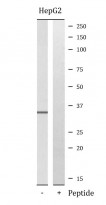ARG66690
anti-SIX2 antibody
anti-SIX2 antibody for Western blot and Human
Overview
| Product Description | Rabbit Polyclonal antibody recognizes SIX2 |
|---|---|
| Tested Reactivity | Hu |
| Tested Application | WB |
| Host | Rabbit |
| Clonality | Polyclonal |
| Isotype | IgG |
| Target Name | SIX2 |
| Antigen Species | Human |
| Immunogen | Synthetic peptide within aa. 30-110 of Human SIX2. |
| Conjugation | Un-conjugated |
| Alternate Names | Sine oculis homeobox homolog 2; Homeobox protein SIX2 |
Application Instructions
| Application Suggestion |
|
||||
|---|---|---|---|---|---|
| Application Note | * The dilutions indicate recommended starting dilutions and the optimal dilutions or concentrations should be determined by the scientist. | ||||
| Positive Control | HepG2 | ||||
| Observed Size | ~ 32 kDa |
Properties
| Form | Liquid |
|---|---|
| Purification | Affinity purification with immunogen. |
| Buffer | PBS, 0.02% Sodium azide, 50% Glycerol and 0.5% BSA. |
| Preservative | 0.02% Sodium azide |
| Stabilizer | 50% Glycerol and 0.5% BSA |
| Concentration | 1 mg/ml |
| Storage Instruction | For continuous use, store undiluted antibody at 2-8°C for up to a week. For long-term storage, aliquot and store at -20°C. Storage in frost free freezers is not recommended. Avoid repeated freeze/thaw cycles. Suggest spin the vial prior to opening. The antibody solution should be gently mixed before use. |
| Note | For laboratory research only, not for drug, diagnostic or other use. |
Bioinformation
| Database Links | |
|---|---|
| Gene Symbol | SIX2 |
| Gene Full Name | SIX homeobox 2 |
| Background | This gene is a member of the vertebrate gene family which encode proteins homologous to the Drosophila 'sine oculis' homeobox protein. The encoded protein is a transcription factor which, like other members of this gene family, may be involved in limb or eye development. [provided by RefSeq, Dec 2008] |
| Function | Transcription factor that plays an important role in the development of several organs, including kidney, skull and stomach. During kidney development, maintains cap mesenchyme multipotent nephron progenitor cells in an undifferentiated state by opposing the inductive signals emanating from the ureteric bud and cooperates with WNT9B to promote renewing progenitor cells proliferation. Acts through its interaction with TCF7L2 and OSR1 in a canonical Wnt signaling independent manner preventing transcription of differentiation genes in cap mesenchyme such as WNT4. Also acts independently of OSR1 to activate expression of many cap mesenchyme genes, including itself, GDNF and OSR1. During craniofacial development plays a role in growth and elongation of the cranial base through regulation of chondrocyte differentiation. During stomach organogenesis, controls pyloric sphincter formation and mucosal growth through regulation of a gene network including NKX2-5, BMPR1B, BMP4, SOX9 and GREM1. During branchial arch development, acts to mediate HOXA2 control over the insulin-like growth factor pathway. Also may be involved in limb tendon and ligament development (By similarity). Plays a role in cell proliferation and migration. [UniProt] |
| Cellular Localization | Nucleus. [UniProt] |
| Calculated MW | 32 kDa |
Images (1) Click the Picture to Zoom In






